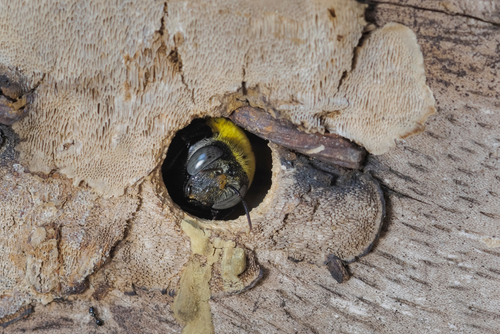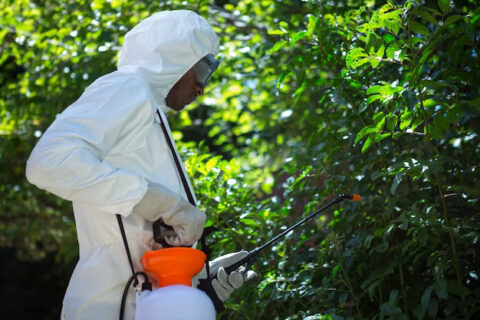Carpenter Bees Can Cause Major Damage to Buffalo Area Homes.
Carpenter bees can cause damage to your home, especially wooden structures like decks, porches, and eaves. These large, black and yellow bees drill into wood to make nests, which can weaken the structural integrity of your home and cause expensive repairs. The tunnels they create are perfectly round and can leave unsightly holes and stains. Over time, the damage can spread to other boards and warp the frame of the structure, causing walls to bulge, floors to sink, and ceilings to dip.
Unlike their more social bee relatives, carpenter bees live a solitary lifestyle. But their wood-boring nesting habits can lead to costly repairs and compromised structures if left unchecked. Understanding these bees’ behavior, recognizing infestation signs, and taking proper control measures are crucial for Western New York homeowners.
Carpenter bees resemble bumblebees but have a distinct smooth, glossy black abdomen. Instead of nesting in the ground like bumblebees, they bore into wood to create their nests. They’re drawn to untreated, exposed wood found in deck railings, roof eaves, wooden furniture and more. While they don’t actually eat the wood itself, the tunnels they drill can weaken structures over time and cause significant damage.
Signs You’ve Got Carpenter Bees The most obvious indicators of a carpenter bee infestation include:
- Round, smooth, finger-width holes on wooden surfaces (the entry point to their nest tunnels)
- Piles of sawdust-like material beneath these holes from their drilling activity
- Staining around the holes caused by bee waste/excrement
- Seeing the bees hovering around your home’s eaves, decks or other wood structures
Costly Impact in WNY When carpenter bees take up residence, it can spell trouble for Buffalo homeowners. The wooden elements of your home’s structure can become compromised over time as their tunneling weakens the integrity. Severe, repeated infestations may eventually require pricey repairs and reinforcement. Their presence also tends to attract woodpeckers, which exacerbate the existing damage as they drill into wood trying to get at the bees and larvae inside.
Taking Control and Preventing Future Problems
- Paint/Treat Wood: Carpenter bees target untreated wood. Painting or staining exposed wooden surfaces deters nesting. Weatherproofing oils and varnishes create a protective barrier.
- Physical Barriers: For problem areas, consider installing aluminum or vinyl siding over vulnerable wooden surfaces they’re attracted to.
- Promptly Fix Damage: Stuff any existing holes with steel wool before sealing with wood filler to discourage bees from reusing them. Addressing these quickly is key, especially in spring before bees emerge.
- Professional Pest Control: For severe, hard-to-control infestations, hire professional exterminators who can provide targeted insecticide treatments and long-term prevention advice specific to carpenter bees in WNY.
- Regular Inspections: Routinely inspect your property (especially wood structures/surfaces) for carpenter bee activity, focusing on spring through early summer when they’re most active. Early detection prevents escalating damage.
Carpenter bees pose a legitimate threat in the Buffalo area, but understanding these pests and taking a proactive approach allows homeowners to effectively control and prevent the damage they can cause. Treating wood surfaces, creating physical barriers, enlisting professional help when needed, and promptly fixing any signs of an infestation helps protect your property’s structural integrity and curb appeal from these destructive wood-boring insects.


